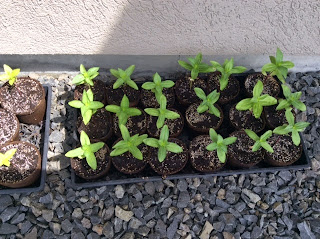Most people are familiar with roses being an esteemed flower; there are formal rose displays and competitions. However, dahlias are also a
beautiful and revered flower. There are hundreds of commercial dahlia growers
throughout the United States. There are also
shows and displays of the blossoms in almost every county. The American Dahlia
Society was founded in 1915. Dahlias are
one of my favorite flowers. I especially
like them in bouquets because their blooms are long lasting.
Dahlias are Mexico’s national flower. Hundreds of years
ago, the single flower type of dahlia grew wild on mountain sides of Mexico.
Today, there is an incredible variety of colors, shapes and sizes of dahlia
flowers due to the creation of many different cultivars or varieties by plant
breeders. The dahlia flower can take on many different forms. This is because dahlias have a larger gene pool
than most flowers. For example, some dahlia flowers are the size of a button
while others are as large as a dinner plate.
Also, there are fourteen different classifications of dahlia petal shape
characteristics.
Dwarf dahlias can
be started from seed or purchased as starter plants. Larger types are often grown from tubers. Tubers differ from
bulbs in that they have eyes; the “eye” on the tuber is actually a bud from where a
new plant will grow. A potato is also a tuber.
Dahlias grow best in
full sun. They like sandy soil for good drainage, as sitting in too much water
can cause the tuber to rot. The soil should be
at least 60 degrees. A ‘rule of
thumb’ for when to plant a dahlia tuber is to plant it the same time as tomato
plants, or in our area, anytime after
Mother’s Day.
To plant the tuber, dig a hole about eight inches deep
and eight inches wide. Fill this planting hole with about four inches of native
soil mixed with a handful of compost. At
this time, sprinkle in some bone meal.
Place the tuber horizontally and then cover it with about three inches of soil.
Fill in with soil around the tuber as it grows. Insert a stake at planting time. As the plant grows,
you will tie the stem to the stake for support. The tuber will sprout in about two to three
weeks.
During my first year growing dahlias, I was excited to
see the tuber sprouts appear above the soil only to find the next day most of
the tender, new shoots were all but gone! Slugs and snails love to devour this young
foliage. Now, I set out snail and slug bait at planting time. When the plant
reaches a foot tall, this is less of a problem. Later, it is a good idea to
remove the lowest leaf sets to reduce further insect damage.
Commercial dahlia growers will pinch off the center stem
after the plant has grown about 18 inches tall; pinching
off causes the plant to grow bushier with more side shoots, flowers, and
stronger stems. Dahlias need lots of water. They may also benefit from a
monthly application of fertilizer that is
high in potash such as 5-10-10. However, a soil test will tell you if potassium
(potash) is deficient in your soil.
Dahlias grow very fast.
In fact, the warmer the temperature, the faster they will grow. By July,
you should have blossoms to cut for your indoor vases. Deadheading or cutting off the faded blooms will encourage more
flowers. This will keep your dahlia
producing flowers up until the first frost.
Dahlia tubers do not survive our cold winters. Digging
up the tubers for winter storage is necessary. Plant the tubers again after the
soil warms for another summer of blooms.
Dahlias are a flower adored by many because they are
easy to grow, and they also provide a finale of color at the end of each
growing season.























